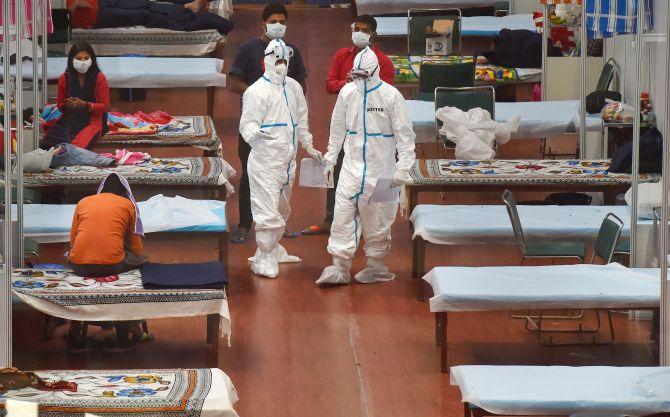Fearing a third wave of COVID-19, the Delhi Disaster Management Authority on Friday approved a four-stage, colour-coded alert system for restricting various activities and functioning of Metro trains, restaurants and shopping malls in accordance with the severity of the pandemic.

The four colour-coded alerts -- Yellow, Amber, Orange and Red -- under the graded response action plan will remove any confusion about enforcement and lifting of various restrictions in the national capital, Chief Minister Arvind Kejriwal said.
Under the new plan, night curfew from 10 pm to 5 am will be imposed in the national capital during three stages -- Yellow, Amber and Orange -- but there will be "total curfew" if 'Red' alert is sounded.
The chief minister demanded such a graded response action plan be adopted at the national level as well.
The plan was approved in a DDMA meeting chaired by Lt Governor Anil Baijal and attended by Kejriwal, his deputy Manish Sisodia, Health Minister Satyendar Jain, Niti Aayog member V K Paul, ICMR Director General Balram Bhargava, AIIMS Director Randeep Guleria and others.
"The Graded Response Action Plan was passed in the DDMA meeting today. No doubts will remain about when the lockdown will be imposed or when it will open.
"Discussion was also held about the Delta plus variant. We have to stop this variant from spreading in Delhi, for which the government is taking all necessary steps," Kejriwal tweeted in Hindi.
The stage of alert will be based on positivity rate (on two consecutive days), cumulative number of new cases (over a week) and average oxygenated-bed occupancy (for a week).
The 'Yellow' (Level-1) alert will be sounded when the positivity rate crosses 0.5 per cent or new cases increase to 1,500 or oxygenated bed occupancy reaches 500.
The corresponding response will involve allowing construction, manufacturing activities and the opening of shops and establishments of essential goods.
However, shops and establishments of non-essential goods and services, and malls will open based on odd-even formula from 10 am to 8 pm. Only one weekly market per zone with 50 per cent vendors will be allowed to open.
Under the 'Yellow alert', restaurants will be permitted with 50 per cent capacity from 8 am to 10 pm while bars can also operate with the same capacity, but from 12 noon to 10 pm.
Also, the Delhi Metro will run at 50 per cent of its seating capacity while auto-rickshaws and cabs can ferry up to two passengers.
Besides, cinema halls, banquet halls, spas, gyms, outdoor yoga activity, entertainment parks and amusement parks will not be allowed if 'Yellow' alert is sounded. Private offices can function with up to 50 per cent of the staff.
The next level of alert coded with 'Amber' (L-2) will come into force if the positivity rate rises above one per cent or new cases number 3,500 or oxygenated bed occupancy reaching 700.
This alert will invoke the same responses mostly as 'Yellow' one except that malls and shops of non-essential goods and services will be allowed to open from 10 am to 6 pm.
The Delhi Metro will run at 33 per cent of its seating capacity in Amber alert under which dining facility in restaurants will not be allowed, but home delivery or take away service will continue.
The 'Orange' or L-3 alert will kick-in if the positivity rate crosses two per cent or new cases number 9,000 or oxygenated bed occupancy becomes 1,000.
Construction activities will be allowed with onsite labourers while industrial activities will be restricted except those related to essential commodities and defense production. Malls and weekly markets will be closed. Only standalone non-essential shops will open from 10 AM to 6 PM, the plan stated.
The 'Red' alert (L-4) will be the highest level and will come into force if the positivity rate crosses five per cent or new cases rise to 16,000 or oxygenated bed occupancy reaches 3,000.
Although most economic activities will not be permitted under the 'Red' alert, construction activities with onsite labourers and industrial manufacturing of essential commodities, national security and defence-related productions will be allowed, while malls and weekly markets will be closed and standalone non-essential shops open.
"With this plan, there will be a sense of certainty and accountability on our part towards the people of Delhi. The plan descriptively elaborates upon when the lockdown will be imposed and when it will be lifted," Kerjiwal was quoted as saying in a government statement.
In May, the Delhi government had formed an eight-member expert committee to devise a strategy to mitigate and manage the possible third wave of COVID-19 in Delhi.
The city government had earlier said it has decided to increase the number of hospital beds to accommodate 37,000 cases a day in case of a possible third wave.
The meeting stressed ensuring an ICU bed capacity of 12,000, sufficient oxygen, drugs and ambulances among others to tackle a possible third wave.











 © 2025
© 2025